Cuisine from the South of France
14 Iconic Dishes from The South of France That You Must Try (And Try to Make!)
1: Ratatouille
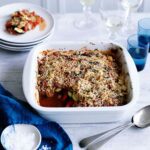 Thanks to health food crazes and the well-known Pixar film of the same name, ratatouille has gone from being a disregarded peasant meal of inexpensive vegetables to an iconic French dish. The stew, which originated in Nice like many of these dishes, is composed of tomatoes, eggplants, onion, zucchini, and bell peppers. It’s slow-cooked with garlic and herbes de Provence into a subtle yet comforting dish that’s so easy to make that you can try it yourself by following the link below!
Thanks to health food crazes and the well-known Pixar film of the same name, ratatouille has gone from being a disregarded peasant meal of inexpensive vegetables to an iconic French dish. The stew, which originated in Nice like many of these dishes, is composed of tomatoes, eggplants, onion, zucchini, and bell peppers. It’s slow-cooked with garlic and herbes de Provence into a subtle yet comforting dish that’s so easy to make that you can try it yourself by following the link below!
HERE is the Recipe.
2: Bouillabaisse with rouille
 Bouillabaisse is a local fish stew that originated in Marseille. It is cooked in a variety of ways in kitchens around the globe, but in Marseille it should always contain three kinds of fish: rockfish, sea robin and European conger. When fishermen couldn’t sell the bony rockfish (rascasse) that they caught, they started making a fish stew to use them up. It’s a delicacy nowadays, and should ideally be prepared ahead of time, which is why the best restaurants like you to order it one or two days in advance.
Bouillabaisse is a local fish stew that originated in Marseille. It is cooked in a variety of ways in kitchens around the globe, but in Marseille it should always contain three kinds of fish: rockfish, sea robin and European conger. When fishermen couldn’t sell the bony rockfish (rascasse) that they caught, they started making a fish stew to use them up. It’s a delicacy nowadays, and should ideally be prepared ahead of time, which is why the best restaurants like you to order it one or two days in advance.
HERE is the recipe
3: Salade Niçoise
 “Salade Niçoise shares the same propensity for misinterpretation as Caesar salad – one rarely sees the original version outside Nice, and even there I have encountered some real hotchpotches. The soul of a great salade Niçoise is, of course, using the best flavoured tomatoes available. While the other vegetables chosen may vary with what is in season there are a few essentials such as green capsicum, cucumbers and black olives. Sliced raw globe artichoke hearts and very tiny raw podded broad beans may be included when available. As to using lettuce, this is not traditional so it is up to individual taste. This salad is best presented on a deep platter so leave adding the dressing and tossing until your beautiful salade Niçoise is on the table. I adore this dish as the colours and aroma transport me to the sunny shores of southern France.”
“Salade Niçoise shares the same propensity for misinterpretation as Caesar salad – one rarely sees the original version outside Nice, and even there I have encountered some real hotchpotches. The soul of a great salade Niçoise is, of course, using the best flavoured tomatoes available. While the other vegetables chosen may vary with what is in season there are a few essentials such as green capsicum, cucumbers and black olives. Sliced raw globe artichoke hearts and very tiny raw podded broad beans may be included when available. As to using lettuce, this is not traditional so it is up to individual taste. This salad is best presented on a deep platter so leave adding the dressing and tossing until your beautiful salade Niçoise is on the table. I adore this dish as the colours and aroma transport me to the sunny shores of southern France.”
HERE is the recipe
4: Cassoulet
 This is our not entirely traditional take on the famed dish originally from the Languedoc region, which includes charcuterie in the form of duck confit, sausages and pork belly. There’s a bit of work involved, but you can prepare the confit duck and sausages ahead before they’re braised in this spectacular feast. Serve it with a green salad dressed with Sherry vinaigrette, and start at least two days ahead to cure the duck and make the sausages.
This is our not entirely traditional take on the famed dish originally from the Languedoc region, which includes charcuterie in the form of duck confit, sausages and pork belly. There’s a bit of work involved, but you can prepare the confit duck and sausages ahead before they’re braised in this spectacular feast. Serve it with a green salad dressed with Sherry vinaigrette, and start at least two days ahead to cure the duck and make the sausages.
HERE is the recipe
5: Pissaladière
 A French pizza? Oui, mais non! Pissaladière bears a striking resemblance to the Italian classic, both in looks and name. Bread dough base? Check (most of the time). Savoury topping? Check. But although its name sounds similar, there doesn’t appear to be any direct etymological link with pizza. To the contrary, pissaladière is derived from the Niçoise condiment, pissalat, which, in turn, is derived from the Latin ‘piscis’, meaning fish.
A French pizza? Oui, mais non! Pissaladière bears a striking resemblance to the Italian classic, both in looks and name. Bread dough base? Check (most of the time). Savoury topping? Check. But although its name sounds similar, there doesn’t appear to be any direct etymological link with pizza. To the contrary, pissaladière is derived from the Niçoise condiment, pissalat, which, in turn, is derived from the Latin ‘piscis’, meaning fish.
Originally made from the fry of sardines and anchovies, pissalat evolved into a pungent mixture of puréed anchovies flavoured with cloves, thyme, bay leaf and pepper and mixed with olive oil. As this condiment isn’t so easy to get hold of outside the Mediterranean area, anchovy fillets are more commonly used instead, but be sure to use the best you can afford.
HERE is the recipe
6: Beef daube
 For carnivores, Daube Provençale is probably the best dish to try. It’s a local beef stew cooked in a daubière, which is a heavy casserole pot. Some of the best restaurants cook their Daube overnight, but the minimum is a few hours, and very slowly. In Provence, the stew has lots of anchovy paste and red wine.
For carnivores, Daube Provençale is probably the best dish to try. It’s a local beef stew cooked in a daubière, which is a heavy casserole pot. Some of the best restaurants cook their Daube overnight, but the minimum is a few hours, and very slowly. In Provence, the stew has lots of anchovy paste and red wine.
The below linked version includes red wine vinegar, which adds a unique piquancy. You’ll need to begin this recipe at least 2 days ahead.
HERE is the recipe
7: Duck Confit
 Once esteemed as a preservation method, cooking and keeping duck in its rendered fat results in meltingly tender, moist, and extremely flavourful meat which can be used in a variety of simple preparations. Sear the duck legs in a hot skillet or shred the meat and add it to salads, or, perhaps best of all, make duck rillettes. Just remember the duck must be salted a day before you plan to cook it.
Once esteemed as a preservation method, cooking and keeping duck in its rendered fat results in meltingly tender, moist, and extremely flavourful meat which can be used in a variety of simple preparations. Sear the duck legs in a hot skillet or shred the meat and add it to salads, or, perhaps best of all, make duck rillettes. Just remember the duck must be salted a day before you plan to cook it.
8: Coq au Vin
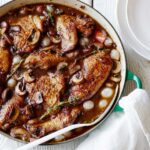 We can not talk about gastronomy in the south of France without mentioning this symbolic dish. The Coq au Vin is prepared in a similar way to the Daube, since the meat is also marinated for a long time in red wine. However, this dish is prepared with rooster or chicken instead of beef, and with onions and turnips instead of carrots and olives.
We can not talk about gastronomy in the south of France without mentioning this symbolic dish. The Coq au Vin is prepared in a similar way to the Daube, since the meat is also marinated for a long time in red wine. However, this dish is prepared with rooster or chicken instead of beef, and with onions and turnips instead of carrots and olives.
This dish is a symbol of the gastronomy of southern France because its invention is attributed to one of the chefs of the emperor Julius Caesar. Legend has it that Julius Caesar took slowly cooked rooster when he finally conquered Gaul after a long military campaign, since the rooster is often used to symbolize France.
HERE is the recipe
9: Onion Soup
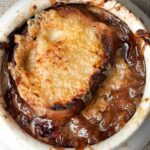 Onion Soup is a soup prepared with caramelized onions in butter, flour and brandy or sherry. The caramelized onion is further cooked in a vegetable or meat broth and finally served in a deep bowl. However, what makes this soup special and what makes it the flagship of the gastronomy of southern France is the way it is presented. The soup is served with grated gruyere or emmental cheese on top of a slice of bread floating in the soup. It is then gratin baked or grilled to form a golden crust.
Onion Soup is a soup prepared with caramelized onions in butter, flour and brandy or sherry. The caramelized onion is further cooked in a vegetable or meat broth and finally served in a deep bowl. However, what makes this soup special and what makes it the flagship of the gastronomy of southern France is the way it is presented. The soup is served with grated gruyere or emmental cheese on top of a slice of bread floating in the soup. It is then gratin baked or grilled to form a golden crust.
HERE is the recipe
10: Fougasse
 Fougasse is a flatbread. Variations can be found across France, originating from Roman times. In Provence, fougasse is normally made with olives and anchovies, and is sometimes topped with cheese as a handy snack.
Fougasse is a flatbread. Variations can be found across France, originating from Roman times. In Provence, fougasse is normally made with olives and anchovies, and is sometimes topped with cheese as a handy snack.
“Entertaining is about breaking bread together, sharing, as opposed to having sliced bread,” says Ross Lusted. “It’s tactile; you want to touch it.”
HERE is the recipe
11: Tapenade
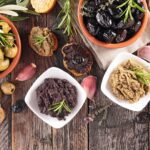 When the southern French have an apéritif, they will often bring out a tapenade to go with their local rosé wine. Tapenade is a spread made from olives, usually with capers, that is spread on large croutons.
When the southern French have an apéritif, they will often bring out a tapenade to go with their local rosé wine. Tapenade is a spread made from olives, usually with capers, that is spread on large croutons.
No ingredient is as deeply associated with the Mediterranean as the olive. Indeed, whether green, black, or Kalamata, these savory little fruits appear everywhere in the cuisine of the region. The Provençal iteration of olive-based seasoning is the now-widespread tapenade. A basic recipe includes olives, capers, anchovies, and plenty of olive oil, a winning combination!
HERE is the recipe
12: Navette
 Would you agree to try a cookie recipe if it was very easy to make, quick and cheap? Just four ingredients: flour, butter, sugar and eggs. The “navette” is a cylindrical cookie flavored with orange blossom, typical of the French Provence. The term “navette” can be translated as “shuttle” in English, referring to Mary Magdalene’s travel to Marseille. These cookies are traditionally eaten at Candlemas. They will keep for several weeks if you store them in a metal box.
Would you agree to try a cookie recipe if it was very easy to make, quick and cheap? Just four ingredients: flour, butter, sugar and eggs. The “navette” is a cylindrical cookie flavored with orange blossom, typical of the French Provence. The term “navette” can be translated as “shuttle” in English, referring to Mary Magdalene’s travel to Marseille. These cookies are traditionally eaten at Candlemas. They will keep for several weeks if you store them in a metal box.
HERE is the recipe
13: Calissons
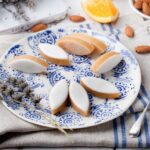 No visit to Aix en Provence would ever be complete without tasting (and falling in love) with the unique almond paste candy known as Calissons. They are delicious and hard to find, yet making them is not so difficult, taking the time to make them from scratch is worth the effort, so you can now easily eat them at home.
No visit to Aix en Provence would ever be complete without tasting (and falling in love) with the unique almond paste candy known as Calissons. They are delicious and hard to find, yet making them is not so difficult, taking the time to make them from scratch is worth the effort, so you can now easily eat them at home.
It is believed the Calisson originally came from medieval Italy, but came to France in 1473, on the occasion of the wedding feast of King René’s second marriage. However, production of the sweet treat became widespread around the 16th century when almonds started to be grown around the Aix en Provence region.
HERE is the recipe
14: Lavender Crème Brulee
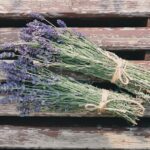 Lavender is renowned as a culinary herb for its clean, distinctive perfume and matching floral, ever-so-slightly-minty flavour. It’s also one of the hardest seasonings to cook with, because of its potential to easily overpower dishes. Discover flavor pairing secrets and learn the professional tricks to cooking with lavender.
Lavender is renowned as a culinary herb for its clean, distinctive perfume and matching floral, ever-so-slightly-minty flavour. It’s also one of the hardest seasonings to cook with, because of its potential to easily overpower dishes. Discover flavor pairing secrets and learn the professional tricks to cooking with lavender.
French lavender is a hybrid plant that goes by the scientific name Lavandula x intermedia. If you want the true Provence lavender experience, the best variety to look for it, unsurprisingly, is Provence. It’s widely regarded as the best French lavender for culinary uses.
The lightest dusting of lavender goes a long way in the kitchen. Use fresh or dried buds but beware: The essence gets stronger and more concentrated as it dries. Use a very light touch or risk infusing the entire dish with bitterness or an oddly soapy flavour. When cooking with dried lavender, use only 1/3 of the amount if the recipe calls for fresh buds. Example: 1 1/2 teaspoons fresh = 1/2 teaspoon dried.
Creme Brûlée is a darling of the French kitchen, as the delicate cream and burnt sugar topping (if done correctly should be like a clear sheet of glass) now boast world renown. Here, the cream meets that most delicious of aromas, classic French lavender.
Clean flavoured lavender and a hint of vanilla give this lavender creme brûlée recipe its signature flavour. The perfume of the flowers is what really gives this special dessert the feel of Provence.
HERE is the recipe
15: Herbes de Provence
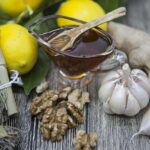 Not so much a dish as they are a common thread between all the famous specialties of the region, herbes de Provence are as fundamental as they are beautiful. The bundle of seasonings, while not a fixed formula, is normally made up of savory, marjoram, rosemary, thyme, and oregano. For a dash of color, lavender is often included (see above), but doesn’t fit into the flavor palette. A special spice blend can make a great Provençal souvenir to commemorate your trip and bring a bit of France home with you!
Not so much a dish as they are a common thread between all the famous specialties of the region, herbes de Provence are as fundamental as they are beautiful. The bundle of seasonings, while not a fixed formula, is normally made up of savory, marjoram, rosemary, thyme, and oregano. For a dash of color, lavender is often included (see above), but doesn’t fit into the flavor palette. A special spice blend can make a great Provençal souvenir to commemorate your trip and bring a bit of France home with you!
HERE is the recipe
Rosé All Day With These 10 Rosé Wines From Provence France:
There’s no doubt that rosé is the perfect wine for summer, and you certainly don’t have to ask us twice when a plan includes to ‘rosé all day’. This wine is blushing in colour, light and crisp in taste, totally refreshing by nature and now even better than ever thanks to the increased selection available at the LCBO here in Ontario.
Here are 10 delicious rosé wines from Provence, France that are all now available at the LCBO. Cool fact about wine and Provence; did you know that Provence is France’s oldest wine region and produces the leading amount of rosé in the world?!
The Vins De Provence vineyards date back to the Ancient Romans in the 2nd century B.C. so there’s a little history in every bottle. Now you can take a little bit of France home with you when you shop any of these 10 rosé wines.
Terres De Saint Louis Rose Varois en Provence
 A pale pink hue with a purple tinge, this Rosé is deliciously tangy with fresh fruit and citrus aromas that match perfectly with Mediterranean cuisine! Terres De Saint Louis Rose Varois en Provence retails for $11.95
A pale pink hue with a purple tinge, this Rosé is deliciously tangy with fresh fruit and citrus aromas that match perfectly with Mediterranean cuisine! Terres De Saint Louis Rose Varois en Provence retails for $11.95
Pink Gecko
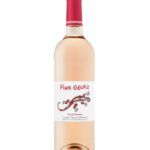 With a bit of a fruity vibe, this Rosé has a complex nose with dominant citrus notes throughout. We love the elegant floral touches and crisp taste! Pink Gecko retails for $14.35
With a bit of a fruity vibe, this Rosé has a complex nose with dominant citrus notes throughout. We love the elegant floral touches and crisp taste! Pink Gecko retails for $14.35
Gassier Sables d’Azur Rosé
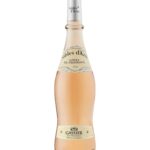 Sustainably produced, this elegant rosé has delicate hints of red currant and clementine and sweet grapefruit. Crisp in taste and a perfect peachy tone, this rosé is the perfect aperitif to grilled fish and even sushi! Gassier Sables D’Azur retails for $16.95
Sustainably produced, this elegant rosé has delicate hints of red currant and clementine and sweet grapefruit. Crisp in taste and a perfect peachy tone, this rosé is the perfect aperitif to grilled fish and even sushi! Gassier Sables D’Azur retails for $16.95
Château de Berne Terres de Berne Rosé
 This apricot tinted Rosé is elegant and full of floral notes like freesia, peach and apricot that pair beautifully with Italian antipasti like melon & proscuitto and fritto misto! Château de Berne Terres de Berne Rosé retails for $16.95
This apricot tinted Rosé is elegant and full of floral notes like freesia, peach and apricot that pair beautifully with Italian antipasti like melon & proscuitto and fritto misto! Château de Berne Terres de Berne Rosé retails for $16.95
Château la Tour de L’évêque Rosé 2016
 The perfect pairing for poultry, seafood and even Asian dishes, this Rosé is lightly pressed so its sweetness and fragrance remain paramount! Château La Tour de L’Évêque retails for $18.95
The perfect pairing for poultry, seafood and even Asian dishes, this Rosé is lightly pressed so its sweetness and fragrance remain paramount! Château La Tour de L’Évêque retails for $18.95
Carte Noire Rosé 2016
 This dry Rosé has floral notes that are complimented with a slightly spicy finish. The grapes are only picked at night and are pressed when cold and are decanted 24 hours later! Carte Noire Rosé retails for $18.95
This dry Rosé has floral notes that are complimented with a slightly spicy finish. The grapes are only picked at night and are pressed when cold and are decanted 24 hours later! Carte Noire Rosé retails for $18.95
La Riviera Côtes de Provence Rosé
 With notes of stone fruit and nuances of vanilla, this Rosé is ideal for a summer buffet or BBQ! The grapes are harvested in the night when it’s cool and are macerated for 2 hours! La Riviera Côtes de Provence retails for $18.95
With notes of stone fruit and nuances of vanilla, this Rosé is ideal for a summer buffet or BBQ! The grapes are harvested in the night when it’s cool and are macerated for 2 hours! La Riviera Côtes de Provence retails for $18.95
Caves d’Esclans Whispering Angel Rosé
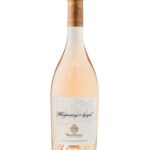 The palest coral pink, this tangy Rosé offers notes of grapefruit and is quickly becoming a local fave! The grapes are harvested only between sunrise to noon and the grapes are from the best land in the surrounding region of Provence! Caves d’Esclans retails for $26.95
The palest coral pink, this tangy Rosé offers notes of grapefruit and is quickly becoming a local fave! The grapes are harvested only between sunrise to noon and the grapes are from the best land in the surrounding region of Provence! Caves d’Esclans retails for $26.95
Saint Aix Rosé 2016
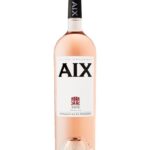 Top quality of all the Provence Rosé, this baby is fruity and delicate with hints of watermelon, strawberries and florals. Definitely the perfect option for a summer dinner party! Saint Aix Rosé retails for $45.95
Top quality of all the Provence Rosé, this baby is fruity and delicate with hints of watermelon, strawberries and florals. Definitely the perfect option for a summer dinner party! Saint Aix Rosé retails for $45.95
BLANQUETTE DE LIMOUX:
Blanquette de Limoux bears the honour of being the first sparkling wine to be produced in France, long before Champagne became the undisputed world leader for this style. “Blanquette” actually just means “white” in the local Occitan language.
Blanquette de Limoux is made using what is known as the traditional method. During pressing of the grapes, the first juice is collected to make the prestige or ‘tête de cuvée’. The wines are then blended and a second fermentation in the bottle is produced by adding the ‘tirage’ liqueur. Whilst the wines spend nine months on the lees, the secondary bottle fermentation occurs. During this process, the remaining sediment is brought towards the neck of the bottle by daily riddling. After nine months, the neck of the bottle is frozen to expel the trapped sediment. Before the bottle is sealed with the final cork, the dosage is added, giving the wine its very dry, dry or medium dry flavour.
Antech Blanquette de Limoux Nature Brut
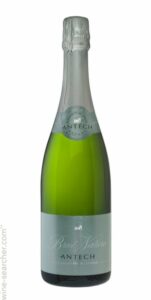 Wine Notes:
Wine Notes:
-This is the third most highly rated Blanquette de Limoux wine (based on critic scores).
-Awarded Bronze from the Decanter World Wine Awards.
-Average Price CA$ 20 (CAD)
Antech Blanquette de Limoux Grande Reserve Brut
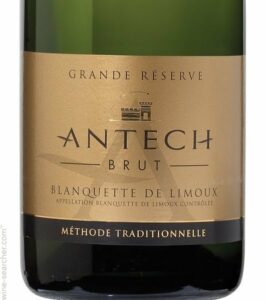 Tasting Notes:
Tasting Notes:
-2 Stars from the Guide Hachette des Vins was awarded.
-This is the eighth most popular wine from Blanquette de Limoux. Moreover, this wine has been getting more popular over the past year.
-This producer makes many wines including those from grapes Rare White Blend, Rare Rose Blend, and Chardonnay – Chenin Blanc.
-Average Price CA$ 19 (CAD)
Vergnes Domaine Martinolles Blanquette de Limoux Methode Ancestrale
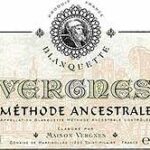
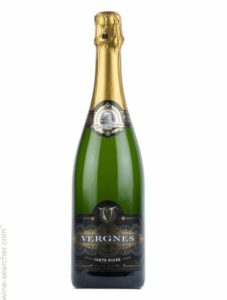 Wine Notes:
Wine Notes:
-This is among the top 10 most highly rated Blanquette de Limoux Methode Ancestrale wines (based on critic scores).
-Ranked second among the wines from this region with respect to number of prizes won: 2 Stars from the Guide Hachette des Vins was awarded as well as 1 Star from the Guide Hachette des Vins.
-Priced above average for white wine from Blanquette de Limoux Methode Ancestrale.
-Average Price CA$ 19 (CAD)
Chateau Rives-Blanques Blanquette de Limoux Brut
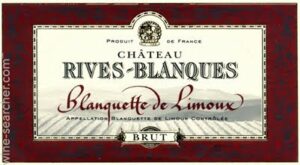 Wine Notes:
Wine Notes:
-Several important critics have rated this Blanquette de Limoux wine highly.
-The Guide Hachette des Vins awarded the 2001 vintage 1 Star.
-One of the most expensive white wines from Blanquette de Limoux (top 10).
-Average Price CA$ 22 (CAD)
Sieur d'Arques Blanquette de Limoux Premiere Bulle N1 Fuschia Brut
 Wine Notes:
Wine Notes:
-Ranked second among the wines from this region with respect to number of prizes won: the 2009 vintage was awarded Gold from the Mundus Vini as well as Gold from the Vinalies Internationales.
-This Blanquette de Limoux wine has received good scores from various critics.
-This is the third most sought-after wine from the region (in terms of user searches).
-Average Price CA$ 15 (CAD)


 Find booking your own travel just too much work? Consider using our
Find booking your own travel just too much work? Consider using our